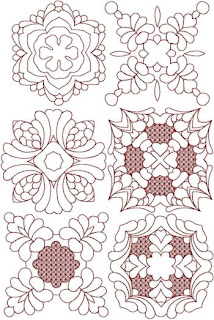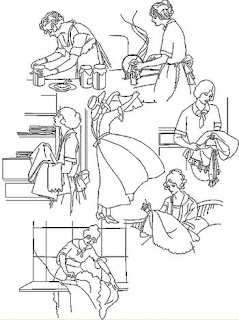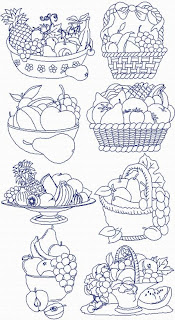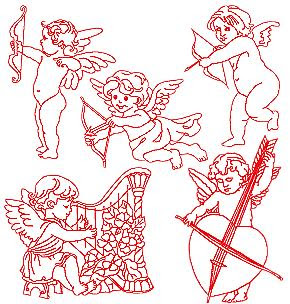Alaska Crafts&Friends
Anchorage Crafts Community
Arts, Crafts and friends in Anchorage.
If you want to help me to create a Craft Community in Anchorage, please contact me on my email meglitle@hotmail.com
If you want to help me to create a Craft Community in Anchorage, please contact me on my email meglitle@hotmail.com
7/01/2010
Redwork Instructions
Do you love the look of Redwork? Here are easy Redwork instructions to help you get started. Redwork has a timeless appeal and is easy to do. See for yourself!
To replicate the "turkey-red" color, try DMC #304 (Medium Christmas Red) or DMC 498 (Dark Christmas Red). For Blue Redwork, DMC #312 is often used.
How many strands of floss to use depends on the effect you are trying to achieve. Use:
According to my research on the subject of red floss, many embroiderers don't believe modern red floss is colorfast even though the manufacturers state they are. It has been suggested that you soak your floss in vinegar and water for 20 minutes then roll it in a towel to wring it out and hang it to let it air dry. This is supposed to keep if from "bleeding" on your embroidery piece. (I don't personally know if it's necessary or if this works, so if you have any information on this, please share it with us!) Since colorfastness is a question, be sure to keep your floss dry while working with it. This also includes not wetting it to thread your needle. If you do, you run the risk of having the red bleed onto your fabric. If threading your needle is a problem, use a needle threader. They are inexpensive and can be found in any sewing or craft store.
transferring your designs for more information.
Needle
Choosing a needle is one of preference. Any needle fine enough not to damage the fabric and has an eye big enough to accommodate the thread can be used. Experiment with a number of different needles to see which one you prefer.Thread
Any color of any type of thread may be used. To achieve the "authentic" Victorian look, use either red or blue floss.To replicate the "turkey-red" color, try DMC #304 (Medium Christmas Red) or DMC 498 (Dark Christmas Red). For Blue Redwork, DMC #312 is often used.
How many strands of floss to use depends on the effect you are trying to achieve. Use:
- One (1) thread for very delicate lines
- Two (2) threads are usually used by embroiderers for the body of the work
- Three or four (3 - 4) threads for a bolder coverage.
According to my research on the subject of red floss, many embroiderers don't believe modern red floss is colorfast even though the manufacturers state they are. It has been suggested that you soak your floss in vinegar and water for 20 minutes then roll it in a towel to wring it out and hang it to let it air dry. This is supposed to keep if from "bleeding" on your embroidery piece. (I don't personally know if it's necessary or if this works, so if you have any information on this, please share it with us!) Since colorfastness is a question, be sure to keep your floss dry while working with it. This also includes not wetting it to thread your needle. If you do, you run the risk of having the red bleed onto your fabric. If threading your needle is a problem, use a needle threader. They are inexpensive and can be found in any sewing or craft store.
Stitches Used
One of the things that attracted embroiderers to Redwork was the simple embroidery stitches used. Stitches most commonly used are:- Backstitch -A stitch made by inserting the needle at the midpoint of a preceding stitch so that the stitches overlap by half-lengths.
- Outline stitch or Stem Stitch - consists of a long stitch forward on the face of the material, and a very short stitch back on the under side. This is also called "cording stitch" or "stem stitch." The needle is brought up beside the preceding stitch.
Please note: The Backstitch and Outline Stitch are two DIFFERENT stitches - although similar. When working the Outline (Stem) stitch the thread stays below or to the right of the needle when it's inserted into the fabric. When working the Outline Stitch, the thread stays above or to the left of the needle when it's inserted into the fabric.
- Split Stitch. This stitch was used often on tight curves. A split stitch is made like an outline stitch but the needle is brought up through the preceding stitch, instead of beside it.
Other stitches Used
The following stitches are used to enhance Redwork. They are to be used sparingly, if at all.- French knots. French knots are used primarily for the center of flowers, seeds, or anywhere small dots are needed. A French Knot is made by twisting the needle once or twice around the thread, passing the needle straight down through the material, and drawing the knot tight.
- Straight Stitch. This stitch was used for small straight lines.
- Satin Stitch. This type of stitch was used to emphasize a certain part of a design. A Satin Stitch consists of regular long stitches closely laid together to represent a smooth, raised, satin-like effect.
Fabric
Redwork was worked on plain cotton muslin. Today cotton muslin can still be easily found in both white and ecru. Although Redwork can be work on almost any fabric with good results, most embroiderers prefer to use cotton muslin because it is "authentic" and provides the look of an old Redwork piece. Whatever fabric you use, don't forget to wash it BEFORE you start your project!Transfer your design onto your fabric.
There are a number of ways to do that easily. Seetransferring your designs for more information.
Hoop
Using a hoop is your preference. Many embroiderers find using a hoop when working with Redwork helpful. See more about Hoops. Redwork DesignsRedwork designs can be found on the Internet or old books. Since Redwork designs are simple line drawings, you can use almost any kind of pattern to make your own. Children's coloring books are a great source. Another great source for outline drawings, that are FREE, is Dover Publications. Sign up for their newsletter and you will be notified of books for sale that week. Each book generally has two or three pages you can download. They even give the instructions on how to do this. I have found many nice designs that would be great for Redwork there.6/27/2010
History of Redwork
Redwork is believed to have originated in Europe in the early 1800’s and traveled to America around 1850 with the availability of color fast red floss. The availability of color fast red thread and inexpensive cotton fabric led to an abundance of interest in this type of embroidery. From the 1860’s through the 1920’s it became popular for young girls to be taught to embroider using red thread floss on cotton squares using simple patterns. These "penny squares"—the simple cotton and floss could be purchased for a penny in dry goods stores across the country—were quickly stitched and often put together block by block into lightweight bed covers.
The outline or running stitch is used primarily for the design with the occasional more fancy stitches of Crazy Quilting being added for embellishment.
Redwork designs were used for home decorating during this time period. Vintage Redwork pieces can be found across America today at antique stores and flea markets. The designs were usually used in dresser scarves, coverlets, towels, and other items for home decoration. This type of embroidery was applied to very functional pieces of linen or cotton that were meant to withstand daily use. It was not unusual for moral sayings expressing the virtues of hard work to be stitched in script with flowers added for a charming effect.
A resurgence in this simple embroidery began in the late 1990’s and continues today. Redwork groups have sprung up at quilt stores as women fall in love with the simplicity of the vintage designs and the easy use of the patterns.
Subscribe to:
Posts (Atom)











































